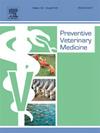Brucellosis in Timor-Leste: Knowledge, attitudes, and practices among cattle farmers and animal health workers
IF 2.4
2区 农林科学
Q1 VETERINARY SCIENCES
引用次数: 0
Abstract
Introduction
Brucellosis affects both animals and humans. Our study investigates the knowledge, attitudes, and practices (KAP) among cattle farmers and animal health workers in Timor-Leste regarding brucellosis as a cattle and zoonotic disease.
Methods
In 2023, we conducted a census of cattle-farming households across 5 aldeias (hamlets) in Timor-Leste. Animal health workers were also surveyed. The survey contained questions on demographics and KAP regarding brucellosis. Descriptive statistics and regression analyses were performed.
Results
We surveyed 253 cattle farmers and 22 animal health workers. Animal health workers were more likely to have heard of brucellosis than cattle farmers. Almost all cattle farmers were willing to wear gloves while handling birth material to reduce zoonotic exposure (95.3 %; 241/253) and support brucellosis cattle vaccination (95.7 %; 181/189), but fewer were willing to slaughter infected cattle (53.4 %; 101/189). Practices that could result in zoonotic transmission to farmers included slaughtering cattle (20.2 %, 51/253), handling aborted material (17.4 %; 44/253), consuming aborted material (5.5 %, 14/253), and drinking raw buffalo milk (6.3 %; 16/253). Household cattle management practices that could facilitate cattle-to-cattle transmission included communal grazing (92.6 %; 175/189), leaving cattle placenta in the field (88.0 %; 161/183), and leaving cattle aborted materials in the field (42.2 %; 27/64).
Conclusion
The study adds to One Health research in Timor-Leste and improves understanding of community perspectives and practices that may increase the risk of brucellosis transmission. The results are important for informing the co-design of practical and locally adapted strategies with local communities to reduce the transmission of brucellosis in cattle and to humans.
东帝汶的布鲁氏菌病:养牛户和动物卫生工作者的知识、态度和做法
布鲁氏菌病对动物和人类都有影响。我们的研究调查了东帝汶养牛户和动物卫生工作者关于布鲁氏菌病作为牛和人畜共患疾病的知识、态度和做法(KAP)。方法在2023年,我们对东帝汶5个aldeias(小村庄)的养牛户进行了人口普查。动物卫生工作者也接受了调查。该调查包含有关布鲁氏菌病的人口统计和KAP的问题。进行描述性统计和回归分析。结果对253名养牛户和22名动物卫生工作者进行了调查。动物卫生工作者比养牛户更有可能听说过布鲁氏菌病。几乎所有的养牛户都愿意在处理分娩材料时戴手套,以减少人畜共患病的接触(95.3% %;241/253)并支持布鲁氏菌病牛疫苗接种(95.7% %;181/189),但愿意屠宰感染牛的人较少(53.4% %;101/189)。可能导致人畜共患疾病传播给农民的做法包括屠宰牛(20.2% %,51/253)、处理流产材料(17.4% %;44/253),食用流产材料(5.5 %,14/253),饮用生水牛奶(6.3 %;16/253)。能够促进牛与牛之间传播的家庭养牛管理做法包括公共放牧(92.6% %;175/189),将牛胎盘留在田间(88.0 %;161/183),将牛流产材料留在田间(42.2% %;27/64)。结论该研究补充了东帝汶的One Health研究,并提高了对可能增加布鲁氏菌病传播风险的社区观点和做法的理解。这些结果对于与当地社区共同设计实用和适合当地情况的战略以减少布鲁氏菌病在牛和人中的传播具有重要意义。
本文章由计算机程序翻译,如有差异,请以英文原文为准。
求助全文
约1分钟内获得全文
求助全文
来源期刊

Preventive veterinary medicine
农林科学-兽医学
CiteScore
5.60
自引率
7.70%
发文量
184
审稿时长
3 months
期刊介绍:
Preventive Veterinary Medicine is one of the leading international resources for scientific reports on animal health programs and preventive veterinary medicine. The journal follows the guidelines for standardizing and strengthening the reporting of biomedical research which are available from the CONSORT, MOOSE, PRISMA, REFLECT, STARD, and STROBE statements. The journal focuses on:
Epidemiology of health events relevant to domestic and wild animals;
Economic impacts of epidemic and endemic animal and zoonotic diseases;
Latest methods and approaches in veterinary epidemiology;
Disease and infection control or eradication measures;
The "One Health" concept and the relationships between veterinary medicine, human health, animal-production systems, and the environment;
Development of new techniques in surveillance systems and diagnosis;
Evaluation and control of diseases in animal populations.
 求助内容:
求助内容: 应助结果提醒方式:
应助结果提醒方式:


